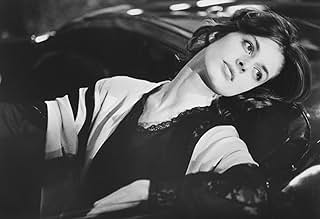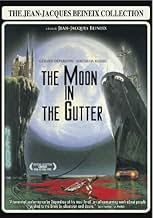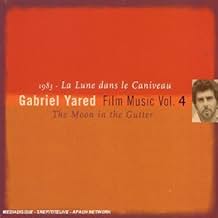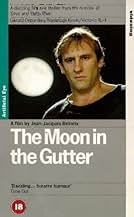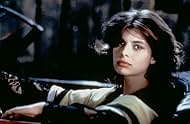CALIFICACIÓN DE IMDb
5.9/10
1.6 k
TU CALIFICACIÓN
Agrega una trama en tu idiomaHe is a revenge-obssessed stevedore whose sister was brutally raped and murdered. She is a wealthy, elusive woman. They try hard to get together... or do they?He is a revenge-obssessed stevedore whose sister was brutally raped and murdered. She is a wealthy, elusive woman. They try hard to get together... or do they?He is a revenge-obssessed stevedore whose sister was brutally raped and murdered. She is a wealthy, elusive woman. They try hard to get together... or do they?
- Dirección
- Guionistas
- Elenco
- Premios
- 1 premio ganado y 4 nominaciones en total
Katya Berger
- Catherine
- (as Katia Berger)
- Dirección
- Guionistas
- Todo el elenco y el equipo
- Producción, taquilla y más en IMDbPro
Opiniones destacadas
Most printed words regarding this film is usually all negative. Criticisms for story and lack of coherence are usually the main issues. The film has has a sad reputation overall, but the atmosphere and cinematography makes up for any shortcomings in the script. The cast-particularly Kinski and Abril really make the film. Depardieu's dedication is serious enough as the lead protagonist. Check the works of Kinski and you'll find no other film of hers giving the aura and beguiling beauty display in The Moon In the Gutter. Regardless,the movie is better than most coming out these days. I would rank it highly with films like "Betty Blue" and the works of Almodovar and Polanski.Hopefully, a proper DVD issue of some kind is imminent.
The second feature from the director of 'Diva' was met with enough ridicule to suggest a settling of old scores, but unfortunately the film deserved every insult it inspired. No one can say Jean-Jacques Beineix wasn't asking for trouble, and the end result of his efforts to create a heavily stylized, romantic mood piece is an unforgivably empty and pretentious melodrama so laughably bad it might almost be a parody of modern European art-schlock cinema. The ubiquitous Gerard Depardieu plays a burly stevedore who wanders the docks of a nameless city, brooding over the unknown assailant who killed his sister; soon he begins brooding over sultry Nastassia Kinski instead, and they elope. Or do they? Every tantalizing hint of a plot disappears (usually within a scene or two) behind a welter of self-indulgent gestures, none of which could possibly make any sense to anyone except the writer-director. At best the film might be dismissed as a failed experiment; more accurately, it's a near masterpiece of unintended awfulness.
10rsoonsa
Jean-Jacques Beineix recently stated (transl.) "An auteur does not speak the truth" and here, within this enormously powerful film, he but flirts with reality, while most of the director's creative fires feed upon his singular employment of colour and set design. The style of Beineix, as a cinematic architect, may be designated as Rococo with, as he avers, a preeminence of (transl.) "atmosphere over narrative", fostering an element of whimsy, greatly enhanced by his recognition of a symbolic authority resting upon commercial advertising and its adjuncts. A studied development of exaggerated imagination marks the film, each frame being carefully composed for a production that originally extended to over four and one half hours, in the face of Beineix' assertion that he abhors filmic structuring. This organizational factor, at least in part, stems from an obligatory reflex of the director as recognition of the film's source, a novel by David Goodis, wherein the action occurs primarily at and about dockside Philadelphia, transferred here to an undesignated Marseille, and with the novelist's prototypical women intact, one, Loretta (Nastassia Kinski), angelic and carnally unattainable, ("you are pure" declaims Gerard Depardieu to her), the second, Bella (Victoria Abril) triumphantly lusty and possessed of will such as the work's protagonist, Gerard Delmas (Depardieu) apparently does not have. Delmas is compulsively drawn to the site of his sister's gruesome death by her own hand following her sexual violation, hoping to discover keys to what prompted her suicide, to the identity of her assailant, and to a rationale behind his own obsession. Thus is formed a basis for a plot, such as it may be, yet style is properly victor over substance with this undervalued and enigmatic piece that is nearly all filmed in studio, the greatest portion lighted by arcs and photo floods, with scoring contributed in elegant and operatically motival fashion by Gabriel Yared, and paced throughout, as Beineix describes it, with (transl.) "slow gestures forming the choreography."
La lune dans le caniveau is definitely different in comparison to director Beineix's much more straightforward crime film Diva (1981). It is more like an introverted, dramatic family member. We observe a man who tries to deal with his mistress and his alcoholic brother, and wants revenge for the death of his sister. Is this story very interesting? I wouldn't say so. Most scenes are long and tedious (the film has a two hour runtime). Only real fans of either Beineix or the actors will keep their concentration until the very end.
The pleasure for the viewer lies elsewhere: the stylistic, colorful cinematography. The film has playful use of lights EVERYWHERE. It is visually incredibly detailed for a film from begin 80's, which were usually bleak on purpose. Both films from Beineix, Diva and this one, weren't praised for its renewal. On the contrary: they were equally bashed by the critics. Style over substance, they said. Which, as an argument about film, seems always ridiculous to me. Isn't cinema BY DEFINITION about style? It is not a book on screen, after all. How is a film as 8 1/2 not style over substance?
While I'll think Beineix was quite adventurous with his colorful style, perhaps even ahead of its time, as films have become more style over substance ever since (take for example V for vendetta, Spring Breakers, Ixjana, City of lost children, The strange color of your body's tears). Also quite modern are these out of the ordinary female characters, played wonderfully by Victoria Abril and Natassja Kinski. Depardieu's acting perhaps seems a bit shallow but he is in fact right in tone with the introverted style of the film. This was a period (begin 80's) in which he excelled in playing lead characters (Danton, Le chevre, Le dernier métro, Buffet froid). I rate this film 7/10. Despite the visual feast, I'm just too impatient to enjoy a film at such a slow pace. An one-hour cut would do magic for this film.
The pleasure for the viewer lies elsewhere: the stylistic, colorful cinematography. The film has playful use of lights EVERYWHERE. It is visually incredibly detailed for a film from begin 80's, which were usually bleak on purpose. Both films from Beineix, Diva and this one, weren't praised for its renewal. On the contrary: they were equally bashed by the critics. Style over substance, they said. Which, as an argument about film, seems always ridiculous to me. Isn't cinema BY DEFINITION about style? It is not a book on screen, after all. How is a film as 8 1/2 not style over substance?
While I'll think Beineix was quite adventurous with his colorful style, perhaps even ahead of its time, as films have become more style over substance ever since (take for example V for vendetta, Spring Breakers, Ixjana, City of lost children, The strange color of your body's tears). Also quite modern are these out of the ordinary female characters, played wonderfully by Victoria Abril and Natassja Kinski. Depardieu's acting perhaps seems a bit shallow but he is in fact right in tone with the introverted style of the film. This was a period (begin 80's) in which he excelled in playing lead characters (Danton, Le chevre, Le dernier métro, Buffet froid). I rate this film 7/10. Despite the visual feast, I'm just too impatient to enjoy a film at such a slow pace. An one-hour cut would do magic for this film.
I saw this what ten years ago. It's timeless. A tale of intrigue. Not for those with limited attention spans! Nastassia's first appearance left me gasping. Lives interconnected, the rich in the playground of the working class. And that ice eating scene had me on the edge of my seat. So dark and challenging. Very few like this out there on the market. I am Glad it wasn't a hit - why spoil it with yet another US remake!!
¿Sabías que…?
- TriviaAfter completing the director's cut of Betty Blue (1986), Jean-Jacques Beineix approached Gaumont with a request that he do the same thing for La lune dans le caniveau (1983). The studio however informed Beineix that all the unused scenes from the film had been destroyed. Beineix has said that the original cut of the film was 4 hours long.
- Créditos curiososPre-credits title: "We're born in the gutter ... where the stars gleam in the water."
- Versiones alternativasThe version released theatrically in US was 11 minutes shorter than the original released in France.
- ConexionesFeatured in Cannes... les 400 coups (1997)
- Bandas sonorasLoretta
Composed and orchestrated by Gabriel Yared
Selecciones populares
Inicia sesión para calificar y agrega a la lista de videos para obtener recomendaciones personalizadas
- How long is The Moon in the Gutter?Con tecnología de Alexa
Detalles
- Fecha de lanzamiento
- Países de origen
- Sitio oficial
- Idioma
- También se conoce como
- The Moon in the Gutter
- Locaciones de filmación
- Productoras
- Ver más créditos de la compañía en IMDbPro
- Tiempo de ejecución
- 2h 17min(137 min)
- Mezcla de sonido
- Relación de aspecto
- 2.35 : 1
Contribuir a esta página
Sugiere una edición o agrega el contenido que falta



